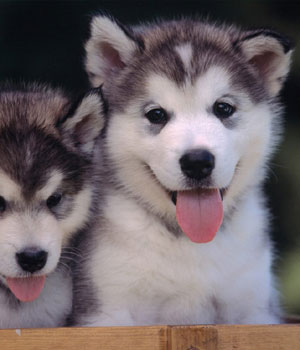Breed Info - Siberian Husky
Overview
|
Breed Group
Working Size Medium How much exercise? More than 2 hours per day Length of coat Short How much grooming? More than once a week |
Sheds?
Yes Town or Country Country Type of home Large House Minimum Garden Size Large Lifespan Over 10 Years |
Description
Mischievous, loyal, outgoing
Mischievous, loyal, outgoing
The breed originates in Eastern Siberia, where it was used by the Chukchi as a long-distance sled-hauling dog. He was later exported to Alaska and Canada, and his country of registration is the USA. He is also known as the Arctic Husky.
The lightest built and fastest of the sled-dog breeds, the Siberian Husky is strictly for the active. He was bred to pull sleds, and, truth to tell, he has few other thoughts in his head. Put him on a lead and he will usually stretch your arm for you; put two or more on leads and they will dislocate your shoulder; let him loose and you may be lucky to see him as he gallops over the horizon!
Temperament wise, he is a delight, although his greeting may be so effusive that he will wind you if he catches you in the midriff. He seems to love the human race and never forgets a friend. His downfall is that he is a natural hunter – and his prey will include the family cat or rabbit.
When the breed standard states that all colours and markings, including white, are allowed, it is quite serious; and the comment about striking patterns not seen in other breeds being found on the head is not an exaggeration. And as for the eyes, just read the phrase in the standard for yourself!
He eats well and is easy to groom, but he can be vocal, and every now and then a group of Sibes will form a choir of doubtful harmony and howl in chorus as they lie cheerfully tethered out in the worst of weathers. That is another breed characteristic – complete indifference to cold and snow. He can also jump anything from the standstill or dig his way under any fence. And having done so, he will not return until it suits him, by which time he may well have sorted out the neighbour’s chickens. In conclusion, then, this is a breed for specialists.
The lightest built and fastest of the sled-dog breeds, the Siberian Husky is strictly for the active. He was bred to pull sleds, and, truth to tell, he has few other thoughts in his head. Put him on a lead and he will usually stretch your arm for you; put two or more on leads and they will dislocate your shoulder; let him loose and you may be lucky to see him as he gallops over the horizon!
Temperament wise, he is a delight, although his greeting may be so effusive that he will wind you if he catches you in the midriff. He seems to love the human race and never forgets a friend. His downfall is that he is a natural hunter – and his prey will include the family cat or rabbit.
When the breed standard states that all colours and markings, including white, are allowed, it is quite serious; and the comment about striking patterns not seen in other breeds being found on the head is not an exaggeration. And as for the eyes, just read the phrase in the standard for yourself!
He eats well and is easy to groom, but he can be vocal, and every now and then a group of Sibes will form a choir of doubtful harmony and howl in chorus as they lie cheerfully tethered out in the worst of weathers. That is another breed characteristic – complete indifference to cold and snow. He can also jump anything from the standstill or dig his way under any fence. And having done so, he will not return until it suits him, by which time he may well have sorted out the neighbour’s chickens. In conclusion, then, this is a breed for specialists.
| |||


